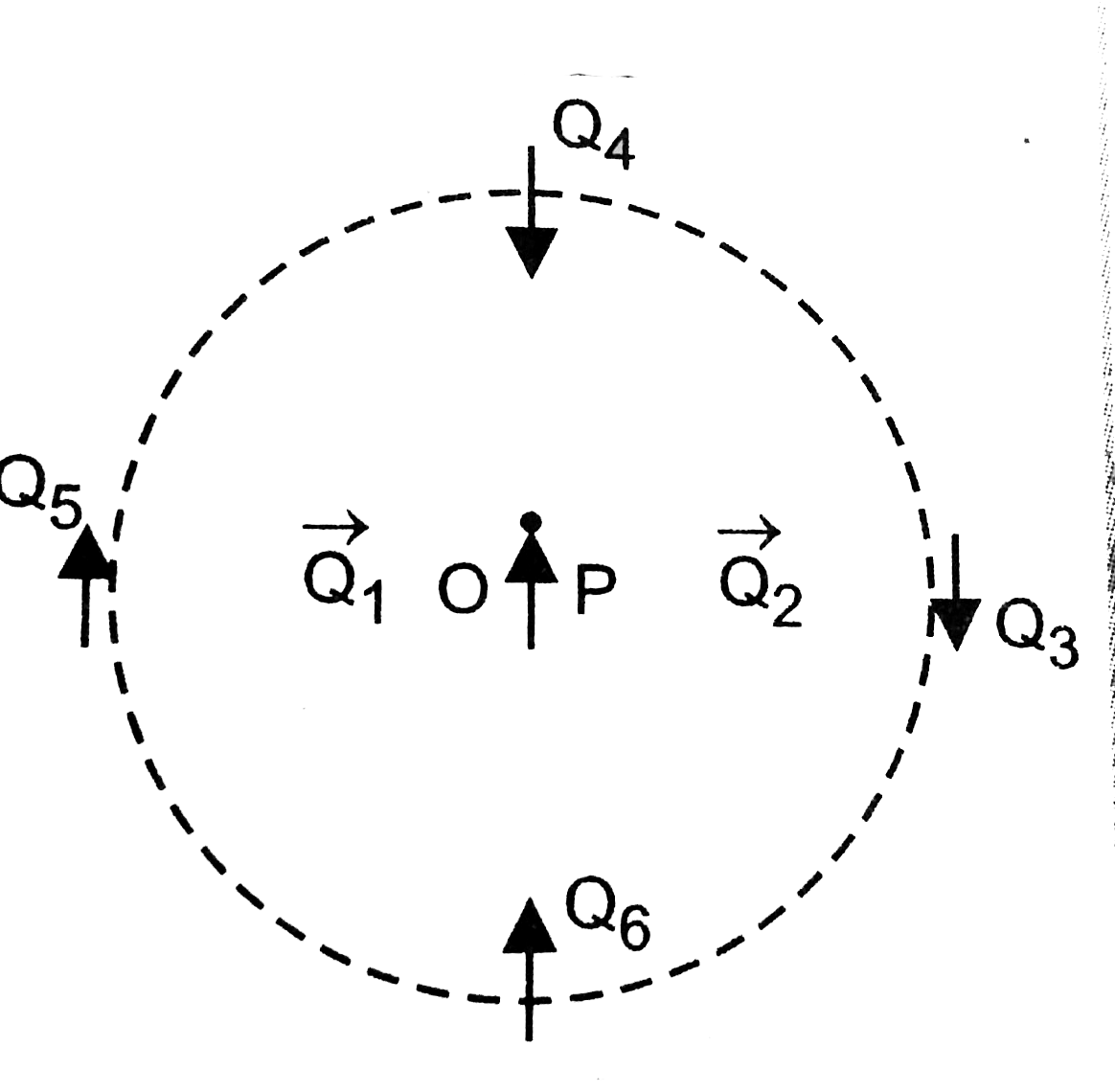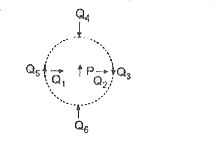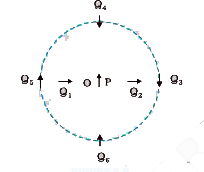Figure shows a small magnetised needle P placed at a point O. the arrow the direction of its magnetic moment. The other arrows show different positions (and orientations of the magnetic moment) of another identical magnetised needle Q.
a. In which configuration the system is not in equilibrium ?
b. In which configuration is the system in (i) stable, and (ii) unstable equilibrium ?
c. Which configuration corresponds to the lowest potential energy among all the configuration shown ?
 Solution in Tamil
Solution in Tamil
Potential energy of the configuration arises due to the potential energy of one dipole (say, Q) in the magnetic field due to other (P). Use the result that the field due to P is given by the expression [Eqs. (5.7) and (5,8)]
BP=−μ0mp4πr3 (on the normal bisector)
Bp=μ024πmpr3 (on the axis)
where mp is the magnetic moment of the dipole P.
Equilibrium is stable when mQ is parallel to Bp and unstable when it is anti parallel to BP.
For instance for the configuration Q3, for which Q is along the perpendicular bisector of the dipole P, the magnetic moment of Q is parallel to the magnetic field at the position 3. Hence Q, is stable. Thus
(a) PQ1andPQ2
(b) (i) PQ3,PQ6(stable)(ii)PQ5,PQ4(unstable)
(c) PQ6
Topper's Solved these Questions
- BOOK - NCERT TAMILCHAPTER - MAGNETISM AND MATTEREXERCISE - Exercises25videos
MAGNETISM AND MATTER
- BOOK - NCERT TAMILCHAPTER - MAGNETISM AND MATTEREXERCISE - Additional Exercises19videos
MAGNETISM AND MATTER
- BOOK - NCERT TAMILCHAPTER - MAGNETISM AND MAGNETIC EFFECTS OF ELECTRIC CURRENTEXERCISE - EVALUATION (IV. Numerical problems)10videos
MAGNETISM AND MAGNETIC EFFECTS OF ELECTRIC CURRENT
- BOOK - NCERT TAMILCHAPTER - MOVING CHARGES AND MAGNETISM EXERCISE - ADDITIONAL EXERCISES17videos
MOVING CHARGES AND MAGNETISM
Similar Questions
Answer the following questions regarding earth's magnetism.
a. A vector needs three quantities conventionally used to specify the earth's magnetic field.
b. The angle of dip at a location in southern India is about 18∘ . Would you expect a greater or smaller dip angle in Britain ?
c. If you made a map of magnetic field lines at Melboune in Australia, would the lines seem to go into the groung or come out of the ground ?
d. In which direction would a compass free to move in the vertical plane point to , if located right on the geomagnetic north or south pole ?
e. the earth' s field, it is claimed roughly approximates the field due to a dipole of magnetic moment 8×1022JT−1 located at its centre. Check the order of magnitude of this number in some way.
f. Geologists claim that besides the main magnetic N - S poles, there are several local poles on the earth's surface oriented in different directions. How is such a thing possible at all ?07:46View SolutionAnswer the following questions .
a. Why does a paramagnetic sample display greater magnetisation (for the same magnetising field) when cooled ?
b. Why is diamagnetism , in contrast , almost independent of temperature ?
c. If a toroid uses bismuth for its core, will the the field in the core be (slightly ) greater or (slightly ) less than when the core is empty ?
d. Is the permeability of a ferromagnetic material independent of the magnetic field ? If not, is it more for lower or higher fields ?
e. Magnetic field lines are always nearly normal to the surface of ferreomgnet at every point . (This fact is analogous to the static electric field lines being normal to the surface of conductor at every point). Why ?
f. Would the maximum possible magnetisation of paramagnetic sample be of the same order of magnitude as the magnetisation of ferromagnet ?07:52View SolutionA bar magnet having a magnetic moment →M is cut into four pieces i.e., first cut in two pieces along the axis of the magnet and each piece is further cut into two pieces. Compute the magnetic moment of each piece.
07:46View SolutionTwo concentric coil X and Y of radii 16cm and 10cm respectively lie in the same vertical plane containing the north-south direction. Coil X has 20 turns and carries a current of 16A, coil Y has 25 turns and carries a current of 18A. The sense of current in X is anti-clockwise and in Y, clockwise, for an observer looking at the coil facing west, Figure. Give the magnitude and direction of the net magnetic field due to the coils at their centre.
 View Solution
View SolutionFigure shows a small magnetized needle P placed at a point O. The arrow shows the direction of magnetic moment. The other arrows show different positions (and orientations of the magnetic moment) of another identical magnetized needle Q.

(a) In which configuration is the system not in equilibrium?
(b) In which configuration is the system in (i) stable and (ii) unstable equilibrium?
(c) Which configuration corresponds to the lowest potential energy among all the configurations shown?08:19View SolutionConsider the situation shown in the diagram, where A small magnetised needle A is placed at a centre marked, as O. The direction of its mangetic moment I s indicated by arrow. The other arrow show different position (and orientations of the magnetic moment) of antoher identical magnetised eedle X. In which configuration the system is not in equlibrium? (ii) In which configuration is the system in (a) stable and (b) unsable equilibrium (iii) Which configuration corresponds to the lowest potentials energy among all the configuration shown
07:46View Solutionचित्र 5.5 में O बिंदु पर रखी गई एक छोटी चुंबकीय सुई P दिखाई गई है! तीर इसके चुंबकीय आघूर्ण की दिशा दर्शाता है! अन्य तीर, दूसरी समरूप चुंबकीय सुई Q की विभिन्न स्थितियों (एव चुंबकीय आघूर्ण के दिकविण्यासो) को प्रदर्शित करते है!
(a) किस विन्यास में यह निकाय संतुलन में नही होगा ?
(b) किस विन्यास में निकाय (i) स्थायी (ii) अस्थायी संतुलन में होंगे?
(c) दिखाए गए सभी विन्यासो में किस्मे न्यूनतम स्थितिज ऊर्जा है?
 07:46View Solution
07:46View SolutionFollowing figures show an arrangement of bar magnets in different configurations . Each magnet has magnetic dipole moment →m . Which configuration has highest net magnetic dipole moment ?
07:46View Solutionचित्र में बिंदु O पर रखी गई एक छोटी चुंबकीय सुई P दिखाई गई है। तीर इसके चुंबकीय आघूर्ण की दिशा दर्शाता है। अन्य तीर दूसरी समरूपचुंबकीय सुई Q की विभिन्न स्थितियों (एवं चुंबकीय आघूर्गों के दिक्विन्यासों) को प्रदर्शित करते हैं।
(a) किस विन्यास में यह निकाय संतुलन में नहीं होगा?
(b) किस विन्यास में निकाय (i) स्थायी, (ii) अस्थायी संतुलन में होंगे?
(c) दिए गए सभी विन्यासों में किसमें न्यूनतम स्थितिज ऊर्जा है?
 03:08View Solution
03:08View SolutionIn the given diagram, a small magnetised needle is placed at a point O. The arrow shows the direction of its magnetic moment. The other arrows shown different positions and orientations of the magnetic moment of another identical magnetic needs B. (a) In which configuration is the systems not in equilibrium?
03:22View SolutionFigure shows a small magnetised needle P placed at a point O. The arrow shows the direction of magnetic moment. The other arrows show different positions (and orientations of the magnetic moment) of another identical magnetised needle Q.

(a) In which configuration is the system not in equilibrium?
(b) In which configuration is the system in (i) stable and (ii) unstable equilibrium?
(c) Which configuration corresponds to the lowest potential energy among all the configurations shown?View SolutionFigure shows a small magnetised needle P placed at a point O. The arrow shows the direction of magnetic moment. The other arrows show different positions (and orientations of the magnetic moment) of another identical magnetised needle Q.

(a) In which configuration is the system not in equilibrium?
(b) In which configuration is the system in (i) stable and (ii) unstable equilibrium?
(c) Which configuration corresponds to the lowest potential energy among all the configurations shown?View SolutionThe figure shows the various positions of small magnetised needles P and Q the arrows show the direction of their magnetic moment which lowest potentical energy among all the configuration shown
? 02:25View Solution
02:25View SolutionWhich configuration is widely used in circuits ?
05:02View SolutionFigure 5.5 shows a small magnetised needle P placed at a point O. The arrow shows the direction of its magnetic moment. The other arrows show different positions (and orientations of the magnetic moment) of another identical magnetised needle Q.
(a) In which configuration the system is not in equilibrium?
(b) In which configuration is the system in (i) stable, and (ii) unstable equilibrium?
(c) Which configuration corresponds to the lowest potential energy among all the configurations shown? 10:18View Solution
10:18View SolutionFigure 5.5 shows a small magnetised needle P placed at a point O. The arrow shows the direction of its magnetic moment. The other arrows show different positions (and orientations of the magnetic moment) of another identical magnetised needle Q.
(a) In which configuration the system is not in equilibrium?
(b) In which configuration is the system in (i) stable, and (ii) unstable equilibrium?
(c) Which configuration corresponds to the lowest potential energy among all the configurations shown? 01:15View Solution
01:15View Solution

